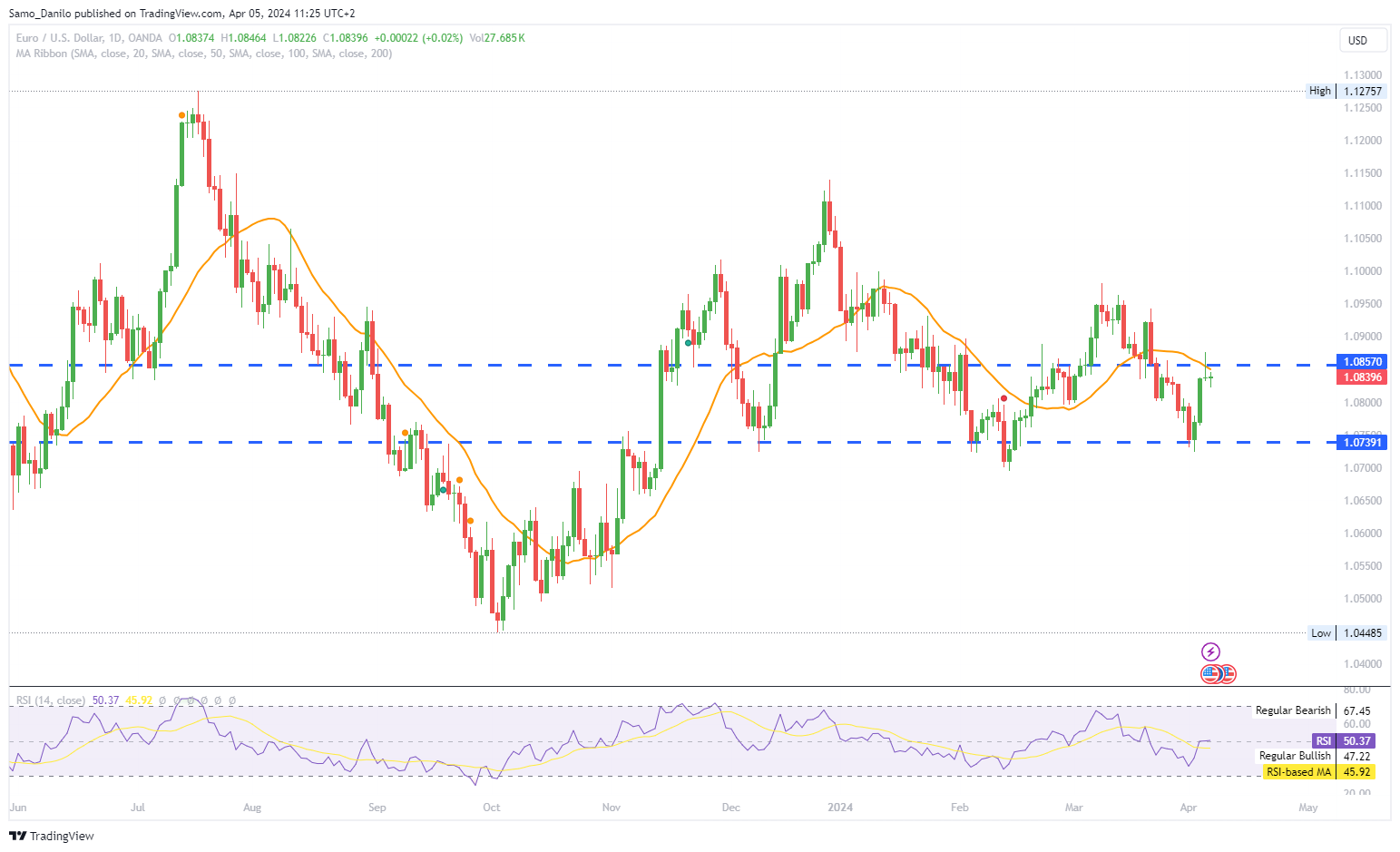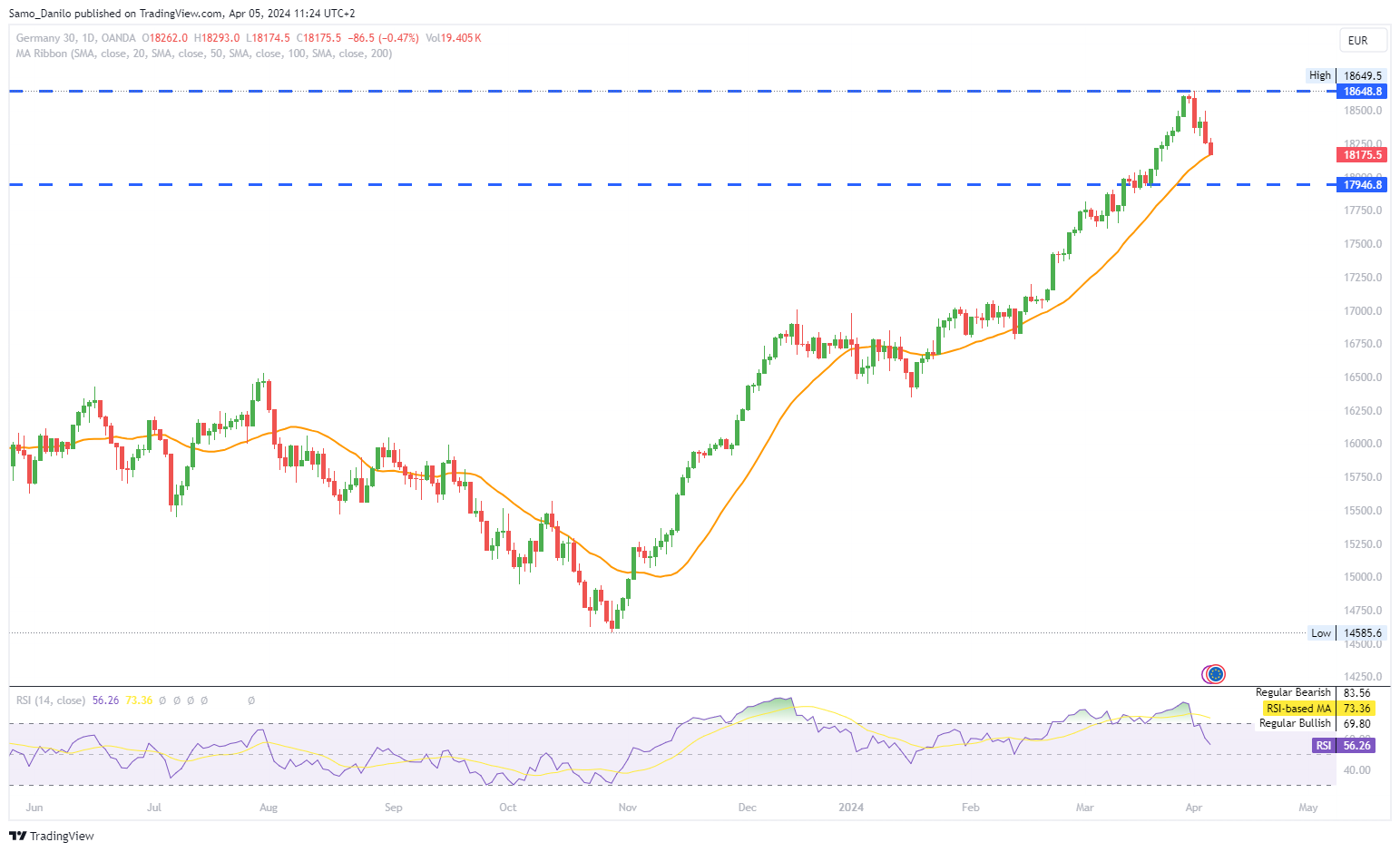EURUSD
- The EUR/USD pair continues its downward trajectory, nearing the 1.0830 level in Friday's European trading, as the US Dollar maintains strength amidst escalating geopolitical tensions in the Middle East.
- Chicago Federal Reserve Bank President Austan Goolsbee highlighted persistent challenges in restoring inflation to the Fed's 2% target, citing substantial price increases in the housing services sector as a major obstacle.
- The ECB's meeting minutes from March 6-7 revealed growing confidence among policymakers regarding inflation's trajectory toward the 2% target.
- Market participants are awaiting Eurozone Retail Sales data on Friday, while also keeping an eye on key US economic indicators such as Average Hourly Earnings and Nonfarm Payrolls.
- With geopolitical tensions and central bank developments influencing market sentiment, traders remain vigilant amid ongoing fluctuations in the EUR/USD exchange rate.
Closing statement: The EUR/USD pair faces continued downward pressure, nearing the 1.0830 level amid a strengthening US Dollar driven by heightened geopolitical tensions in the Middle East. Insights from Chicago Federal Reserve Bank President Austan Goolsbee underscore the persistent challenges in achieving the Fed's inflation target, while ECB meeting minutes reveal growing confidence in inflation trajectory. Market focus shifts to upcoming Eurozone Retail Sales data and key US economic indicators, reflecting ongoing market vigilance amidst geopolitical uncertainties and central bank dynamics.
GBPUSD
- GBP/USD exhibits a slight negative bias around 1.2640 early Friday, with the US Dollar finding support amid heightened market concerns over geopolitical tensions, particularly related to Iran's potential attack on Israel.
- The US Initial Jobless Claims increased to a two-month high, signaling potential challenges in the labor market. The rise in new claims for unemployment benefits adds to market uncertainty.
- Despite the rise in jobless claims, the safe-haven appeal of the USD limits losses as geopolitical tensions persist.
- Market sentiment regarding Bank of England (BoE) rate cuts will likely influence the Pound Sterling (GBP), with investors anticipating potential monetary policy adjustments in June amid slowing UK inflation.
- Investors await key US economic data, including the highly anticipated Non-farm Payrolls report, along with the Unemployment Rate and speeches by several Federal Reserve officials, which could provide further insights into the economic outlook.
| SMA (20) | Slightly Falling |
| |
| RSI (14) | Slightly Rising |
| |
| MACD (12, 26, 9) | Falling |
|
|
Closing statement: GBP/USD maintains a slightly negative bias around 1.2640 amid support for the US Dollar driven by heightened geopolitical tensions, particularly related to concerns over potential hostilities involving Iran and Israel. Rising US Initial Jobless Claims add to market uncertainty, although the safe-haven appeal of the USD caps losses. Market focus shifts to expectations for Bank of England (BoE) rate cuts and key US economic data, including the Non-farm Payrolls report, offering further insights into the economic landscape amidst ongoing geopolitical uncertainties.
GOLD
- Gold continues its correction from record highs for the second consecutive day on Friday, as the precious metal faces downward pressure amid a resurgence in the US Dollar.
- Thursday saw a notable rebound in the US Dollar from two-week lows, driven by hawkish remarks from Federal Reserve officials Goolsbee, Kashkari, and Barkin, leading to increased risk aversion in the market.
- The US Dollar maintains its recovery momentum early Friday amid ongoing risk-off sentiment in Asia, fueled by escalating geopolitical tensions between Israel and Iran.
- Investors are closely eyeing the US Nonfarm Payrolls data, with expectations of the US economy adding 200K jobs in March. Any deviation from this forecast could significantly impact gold prices.
- Weak US economic data could reinforce dovish expectations regarding Federal Reserve policy, potentially prompting gold prices to resume their upward trajectory toward record highs.
| SMA (20) | Rising |
|
|
| RSI (14) | Rising |
|
|
| MACD (12, 26, 9) | Rising |
|
|
Closing statement: Gold experiences a continued correction from record highs for the second consecutive day amid a resurgence in the US Dollar, driven by hawkish remarks from Federal Reserve officials. Ongoing risk-off sentiment in Asia, fueled by escalating geopolitical tensions between Israel and Iran, further supports the US Dollar's recovery. Investors are closely monitoring the US Nonfarm Payrolls data, with expectations of job gains in March potentially impacting gold prices. Any deviation from forecasted figures could influence market expectations regarding Federal Reserve policy and, consequently, Gold's price trajectory.
CRUDE OIL
- West Texas Intermediate (WTI) oil price continues its upward momentum, extending its winning streak since March 27, supported by escalating geopolitical tensions and concerns over potential disruptions in oil supply.
- The recent increase in Crude oil prices is primarily attributed to the looming threat of supply disruptions, particularly following Israel's attack on Iran's embassy in Syria, which has heightened geopolitical tensions in the region.
- NATO officials reported on Thursday that ongoing Ukrainian drone attacks targeting refineries in Russia may have already disrupted approximately 15% of Russian refining capacity, further contributing to supply concerns.
- Challenges persist for a Lukoil refinery in Russia, which is struggling to repair its gasoline unit due to the refusal of assistance from the American firm Universal Oil Products (UOP), adding to supply constraints.
- This week, the Organization of the Petroleum Exporting Countries (OPEC) and its allies, collectively known as OPEC+, opted to maintain their current oil supply policy unchanged, indicating a commitment to stabilizing the oil market amidst escalating geopolitical tensions.
| SMA (20) | Rising |
|
|
| RSI (14) | Rising |
|
|
| MACD (12, 26, 9) | Rising |
|
|
Closing statement: Amid escalating geopolitical tensions and supply concerns, West Texas Intermediate (WTI) oil price continues its upward trajectory, supported by ongoing threats of supply disruptions. Recent events, including Israel's attack on Iran's embassy in Syria and Ukrainian drone strikes on Russian refineries, have heightened concerns over oil supply stability. Furthermore, challenges faced by a Lukoil refinery in Russia and the decision by OPEC+ to maintain current oil supply policies underscore the complexities surrounding the global oil market. As tensions persist, investors remain vigilant, closely monitoring developments that could impact oil prices and market stability.
DAX
- The German Services PMI for March showed improvement, rising from 48.3 to 50.1, signaling expansion in the services sector and supporting investor expectations for a June ECB rate cut.
- Similarly, the Eurozone Services PMI increased from 50.2 to 51.5 in March, indicating a broader improvement in the macroeconomic environment across the euro area.
- US labor market data, including an increase in initial jobless claims from 212k to 221k for the week ending March 30, reinforced investor expectations for a June Fed rate cut.
- Eurozone retail sales data will be crucial, as an unexpected uptick could challenge investor assumptions about a June ECB rate cut, especially if strong consumer spending fuels demand-driven inflation.
- While economic indicators from the euro area are significant, the US economic calendar, particularly the US jobs report, is likely to have a more pronounced impact on investor sentiment and market direction.
| SMA (20) | Rising |
|
|
| RSI (14) | Slightly Rising |
| |
| MACD (12, 26, 9) | Rising |
|
|
Closing statement: Amidst a backdrop of improving economic indicators in the euro area and heightened expectations for monetary policy easing by both the ECB and the Fed, investor sentiment remains cautious. Positive data from the German and Eurozone services sectors support the anticipation of a June ECB rate cut, while mixed signals from the US labor market underscore uncertainty regarding the pace of monetary policy adjustments by the Federal Reserve. As investors await further economic data releases, particularly the US jobs report, market participants are poised to react to any developments that could shape future monetary policy decisions.




